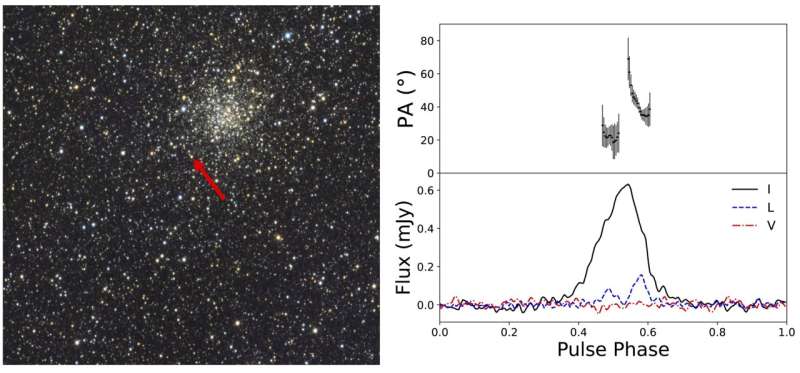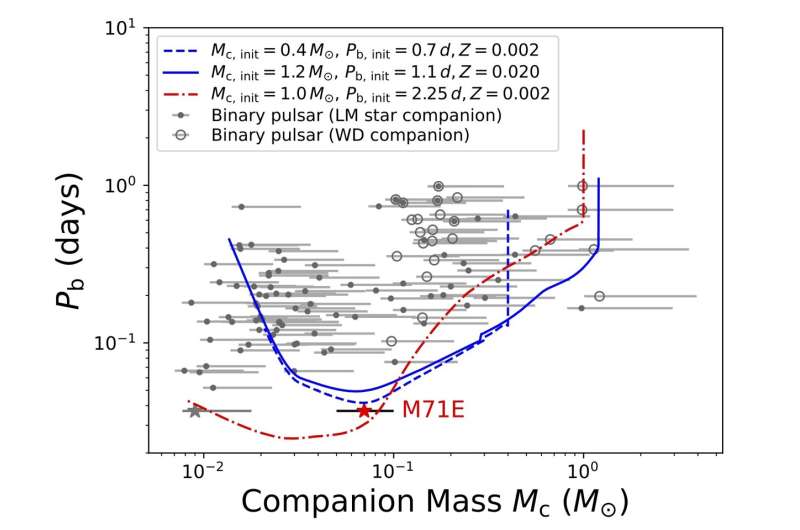This article has been reviewed according to Science X's editorial process and policies. Editors have highlighted the following attributes while ensuring the content's credibility:
fact-checked
peer-reviewed publication
trusted source
proofread
World's largest filled-aperture radio telescope finds missing link in evolution of spider pulsar system

Researchers from the National Astronomical Observatories of the Chinese Academy of Sciences (NAOC) and their collaborators at home and abroad have discovered a binary pulsar with a 53-minute orbital period using the Five-hundred-meter Aperture Spherical radio Telescope (FAST). The discovery of this binary system—named PSR J1953+1844 or M71E—fills the gap in the evolution of spider pulsar systems. The findings were published in Nature on June 20.
The first pulsar was discovered in 1967. As of now, about 3,000 of these fascinating objects, which rotate regularly and quickly like spinning tops in the sky, have been found.
Some pulsars are located in binary systems, orbiting with companion stars. If the two stars are close together, the pulsar will swallow material from the companion star to keep spinning. At the beginning, the companion star is heavy. But as the pulsar "eats" its companion star, the two stars get closer together and orbit each other with increasing speed. In contrast, as the star loses mass and gets lighter, the pulsar can't continue to plunder and thus pushes the companion star away. As a result, the pulsar's orbital speed slows down.

This behavior, which is reminiscent of female spiders eating male spiders, inspired astronomers to name the objects in these two stages after redback and black widow spiders, respectively. They are collectively known as spider pulsars.
The evolution from redback to black widow takes a long time, up to hundreds of millions of years. Previously, only binary pulsar systems in the redback and black widow states had been detected, with no intermediate states yet found. The reason is that the orbital period of the intermediate pulsar predicted by this theory would be very short and the distance between the two stars would be very close, thus posing challenges for observation. For this reason, the theory of the evolution of spider pulsar systems from redback to black widow had not been fully proved.
Now, however, the possibility of this evolutionary path has been confirmed by FAST, the world's largest and most sensitive radio telescope. The research team used long-term observation by FAST to detect a spider pulsar system whose orbital duration is the shortest ever discovered—only 53 minutes. Based on various indications during observation, the researchers determined that the system was in an intermediate state on the evolutionary path from redback to black widow, thus filling in the missing link in spider pulsar evolution theory.

"The orbital of the binary is almost face-on—such a system is extremely rare. FAST found it in the vast sea of stars using its extremely high detection capabilities. This filled the gap in the evolution of spider pulsar systems and reflects [FAST's] unprecedented sensitivity," said Jiang Peng of NAOC, co-corresponding author of the study.
Nature reviewers described the result as a "very interesting pulsar binary system. This discovery shortens the record for the shortest orbital period of a pulsar binary system by about 30%, indicating a new and unknown process in the evolution of spider pulsars."
More information: Z. Pan et al, A Binary Pulsar in a 53-minute Orbit, Nature (2023). DOI: 10.1038/s41586-023-06308-w
Journal information: Nature
Provided by Chinese Academy of Sciences




















